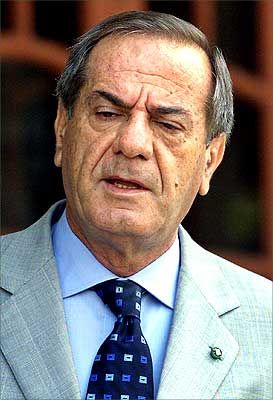 How powerful or influential was Ottavio Quattrocchi, who died in Milan last Friday?
How powerful or influential was Ottavio Quattrocchi, who died in Milan last Friday?
Quattrocchi lived in India for several years as the representative of an Italian firm, Snam Progetti, in the 1980s. He was close to the Gandhi family and in 1999 was named one of the accused in the case regarding the Rs 64-crore pay-off for the supply of 155 mm Howitzer guns made by Bofors, for which a controversial deal was signed in 1986 when Rajiv Gandhi was the prime minister.
But six years before that Bofors charge-sheet could be filed in 1999, Quattrocchi had left India in July 1993. Controversy surrounded the slow and inefficient manner in which the government acted in this case, giving rise to suspicion that Quattrocchi’s connections with the Gandhi family came to his rescue.
Perhaps as controversial as Quattrocchi’s involvement with the Bofors deal was his role in attempts to subvert a high-profile gas pipeline deal that Progetti had lost to another multinational consortium in spite of his hectic lobbying.
In his autobiographical account of his experiences as a civil servant (Two Score and Ten), G V Ramakrishna, an Indian Administrative Services officer who was the petroleum secretary between 1985 and 1988, had revealed the extent of Quattrocchi’s influence on the government of the day.
In February 1985, the government had mooted the project to lay a 1,700-km long pipeline to carry gas from Hazira in Gujarat to Jagdishpur in Uttar Pradesh -- traversing four states (Gujarat, Rajasthan, Madhya Pradesh and Uttar Pradesh) and major rivers, canals and roads.
The pipes had been procured, but the decision was to entrust the entire job of welding, coating and laying the pipeline with a single contractor to ensure the project’s timely completion. Known as the Hazira-Bijaipur-Jagdishpur or HBJ pipeline project, its total cost was estimated at Rs 1,700 crore.
Three firms had qualified to bid for the project and these were Progetti of Italy (with Quattrocchi as its India representative), a consortium of three consisting of Spie Capag of France, Toyo Engineering and NKK of Japan, and a Canadian firm. On opening the bids, it transpired that the lowest bid came from the Spie Capag-led consortium, followed by those of Snam Progetti and the Canadian firm.
The difference between the lowest and the next bid was about Rs 120 crore. This difference was quite high when compared to the total value of the contract, estimated at Rs 700 crore.
The Spie Capag-Toyo-NKK consortium was the clear winner of the project, but this was not acceptable to Quattrocchi of Snam Progetti, which had earlier won several contracts in India for offshore work for Oil and Natural Gas Corp and fertiliser projects.
Quattrocchi met Ramakrishna several times to argue that Snam Progetti’s bid was the lowest after taking into account its financing terms. This was a false claim as Ramakrishna found out that the French and the Japanese, too, had offered financing terms.
Ramakrishna told Quattrocchi and his chief at a meeting that the decision on awarding the HBJ gas pipeline contract to the Spie Capag-led consortium was final.
However, that was not the end of it, as Ramakrishna recounts in his autobiography. Then petroleum minister Naval Kishore Sharma called Ramakrishna to come to his residence one morning in late 1986, along with the HBJ gas pipeline file.
Ramakrishna was offered a cup of coffee and made to wait, while Sharma went out with the file to meet then power minister Arun Nehru. Sharma returned after about half an hour, pulled out a slip of paper, copied the content from that on to the file and handed it back to him “with a wry smile”.
The ministerial instruction was to review the bid evaluation for the HBJ pipeline contract by an official group under then Cabinet secretary P K Kaul. The group had as its members defence advisor V S Arunachalam, expenditure secretary R Ganapati and Ramakrishna.
The secretary of the group was Kamlesh Sharma, a foreign service officer who was then with the finance ministry and who later becameIndia’s high commissioner in England and the secretary-general of the Commonwealth of Nations.
After the constitution of the review committee, Quattrocchi raised with Kaul the issue of the eligibility of one of the partners of the winning consortium. The committee gave its report giving the evaluation process the clean chit and endorsing the award of the contract to the Spie Capag-led consortium.
Quattrocchi was upset. Ramakrishna writes in his autobiography that in about a fortnight of that decision, “Kaul was sent as ambassador to the US” and a little later, Naval Kishore Sharma was shifted out of the petroleum ministry to be made incharge of the Rajasthan unit of the Congress. “I am going now, I don’t know how long you will be here,” Sharma told Ramakrishna as he left the petroleum ministry.
Even after this, there was no let-up in the pressure on Ramakrishna to swing the HBJ gas pipeline deal in favour of Snam Progetti. An attempt was made to split the contract between the French-Japanese consortium and Progetti, which, too, was successfully resisted. Before the agreement could be signed, a series of queries about the details of the deal came from the Prime Minister’s Office.
There was also a query as to who had vetted the contract. Ramakrishna was no green horn as he had already got the deal cleared by the attorney general of India. Another query was on whether the Italian bid was superior to that from the French-Japanese consortium because of the former’s financial package.
This matter was again reviewed by K P Geethakrishnan, who was then an additional secretary in the finance ministry.
There was more drama. After the date of signing the contract was fixed, the HBJ gas pipeline file was called by the PMO. The petroleum minister, Chandrasekhar Singh, asked Ramakrishna to talk to Sarla Grewal, who was then the principal secretary in Rajiv Gandhi’s PMO.
But the matter was not in her hands. Ramakrishna was advised to talk to Satish Sharma, a close family friend of the Gandhis, but he refused to talk to Sharma.
Eventually, the file did not return from the PMO and the signing of the contract had to be deferred indefinitely. A week later, the file was returned to the petroleum ministry and the deal was quietly signed. Such was the clout of Quattrocchi!












 © 2025
© 2025